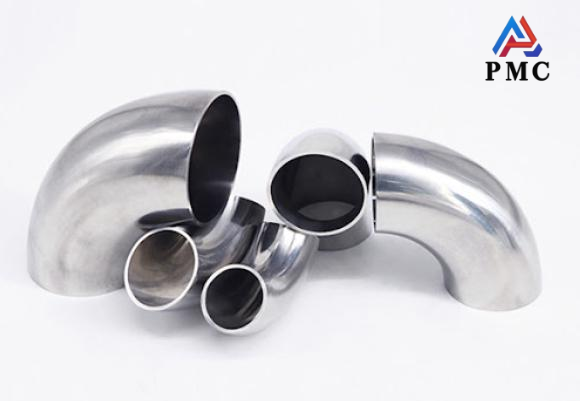
Things to Note when Purchasing Stainless Steel Elbows
What is a stainless steel elbow?
Stainless steel elbows are very common pipe fittings in pipeline systems, mainly used to change the flow direction of fluids and the direction of pipelines. They can be seen in pipeline laying in many fields such as petroleum, chemical industry, electricity, and construction. It is generally made by cold bending or hot bending. Cold bending is usually suitable for stainless steel pipes with smaller diameters and thinner walls. This method can make the elbow surface smoother and have higher dimensional accuracy. Hot bending is often used for pipes with larger diameters and thicker walls. With the help of high temperature, the pipe is more plastic and easier to bend into the desired shape.
Common materials include 304 and 316 stainless steel. 304 stainless steel elbows have good corrosion resistance and heat resistance, and can be used stably in general atmosphere, fresh water, and steam environments; 316 stainless steel elbows have better corrosion resistance due to the addition of molybdenum, and are especially suitable for pipeline systems with corrosive media.
Characteristics of stainless steel elbows
1. Strong corrosion resistance
Stainless steel elbows have strong corrosion resistance, thanks to the chromium, nickel and other alloy elements contained in the material. These elements form a dense oxide film on the surface of the elbow, just like putting on a solid "protective suit" for the elbow, which can effectively block the erosion of external corrosive media. Whether in an acidic or alkaline environment or in a salty marine environment, it can be used stably for a long time and will not be easily corroded.
2. Good mechanical properties
It has high strength and hardness and can withstand greater pressure and fluid load. In the pipeline system, when the fluid flows at high speed or the pressure changes suddenly, the stainless steel elbow will not easily deform or break due to its good mechanical properties, which effectively guarantees the normal operation of the pipeline.
3. High temperature resistance
Stainless steel elbows have good high temperature resistance and can withstand high temperatures without deformation and oxidation. Generally, they can work stably in a high temperature environment. For example, in the steam pipe system of a thermal power plant, the steam temperature is very high. Stainless steel elbows can adapt well to this high temperature environment, realize the connection and diversion of the pipes, ensure the normal transportation of steam, and meet the production needs of power generation.
4. Beautiful and durable
Its surface is smooth and not easy to accumulate dirt. It not only looks beautiful, but also is easy to clean and maintain. This feature is particularly important in some industries such as food, beverage, and pharmaceuticals that have high hygiene requirements. The stainless steel elbow with a smooth surface is easy to clean and can effectively prevent the growth of dirt and bacteria, ensuring the quality and safety of the product. At the same time, its durability also makes it unnecessary to replace frequently during long-term use, reducing the cost of use.

Things to note when purchasing stainless steel elbows
1. Material selection
When purchasing, it is necessary to select the appropriate stainless steel material according to the specific working environment and medium characteristics. Common 304 stainless steel is relatively affordable and can show good corrosion resistance in ordinary atmosphere and fresh water environments. It is suitable for general civil buildings and ordinary industrial pipelines. If there is a strong corrosive medium in the working environment, such as transporting liquids containing acid and alkali components in chemical companies, then 316 stainless steel must be considered.
2. Angle selection
Choose an elbow with a suitable angle according to the pipeline layout and design requirements. 90-degree elbows are suitable for pipeline systems that require right-angle turns. They are often seen in the water supply and drainage pipelines of buildings, and can realize the turning of pipelines in vertical and horizontal directions. 45-degree elbows are suitable for situations where a smaller angle turn is required, such as in some equipment connection pipelines with limited space. Using 45-degree elbows can make the pipeline turn more smoothly and reduce fluid resistance. If there are special pipeline layout requirements, elbows with special angles can also be customized.
3. Size selection
Choose stainless steel elbows of appropriate size according to the diameter and requirements of the pipeline. Pipes of different diameters need to be matched with elbows of corresponding sizes to ensure tight connection with other pipeline connectors and ensure the sealing and stability of the entire pipeline system. For example, in an oil pipeline, if the elbow size does not match the pipeline, it may cause leakage at the connection, affect the transportation of oil, and even cause safety accidents. When choosing the size, strictly refer to the design specifications of the pipeline to avoid unnecessary troubles caused by size deviation.
Conclusion
Stainless steel elbows play a key role in pipeline systems in many fields due to their corrosion resistance, good mechanical properties, high temperature resistance, and beautiful and durable appearance. When purchasing stainless steel elbows, we must fully consider factors such as materials, angles and sizes to ensure that the selected elbows perfectly match the actual usage requirements. Only by deeply understanding the characteristics of stainless steel elbows and strictly following the procurement precautions can we make the right choice, provide strong guarantees for the safe and stable operation of the pipeline system, and thus improve the quality and benefits of the entire project.
Read more: Sealing Performance of Stainless Elbows


